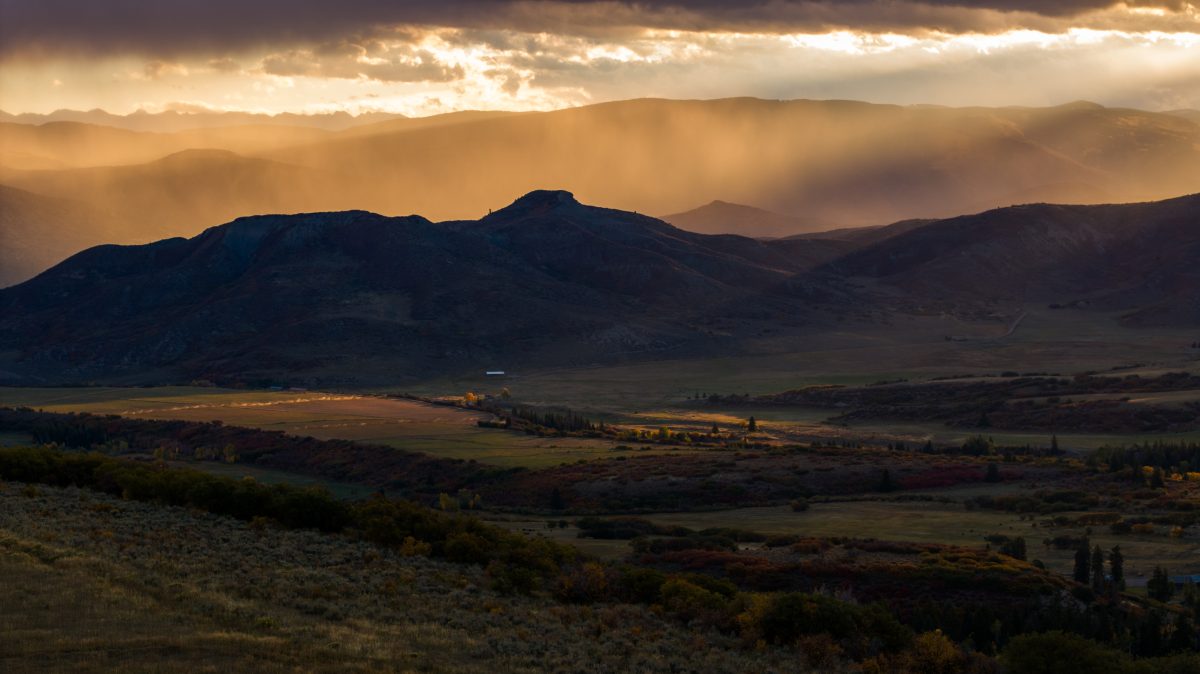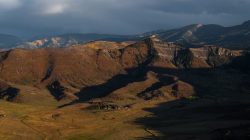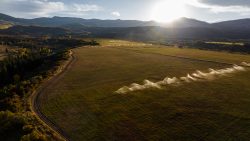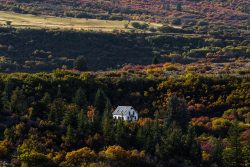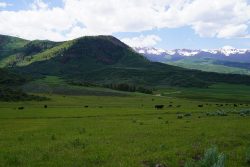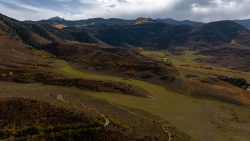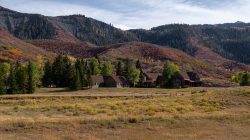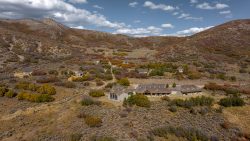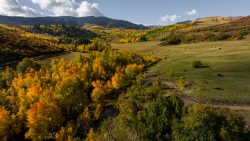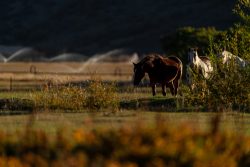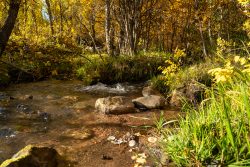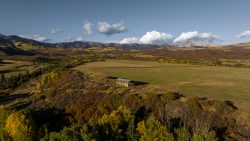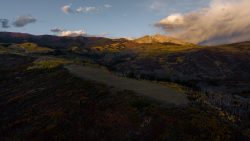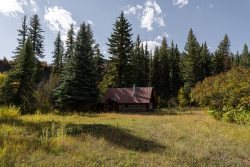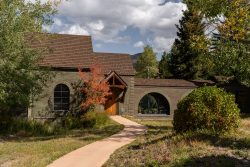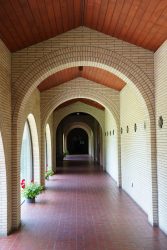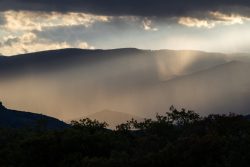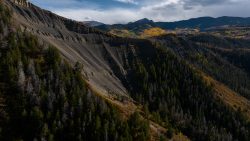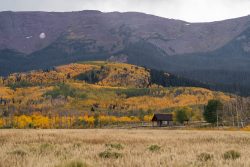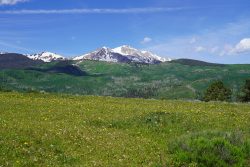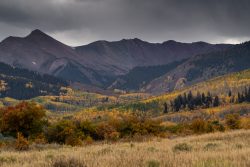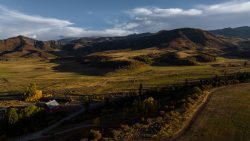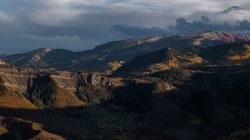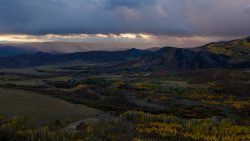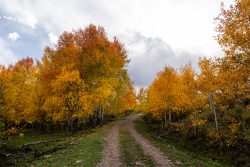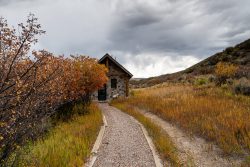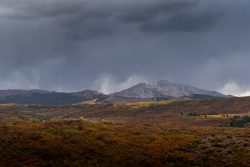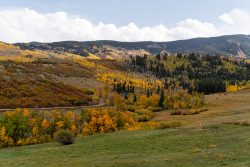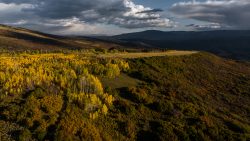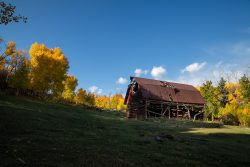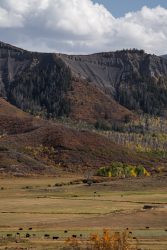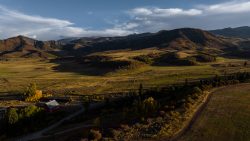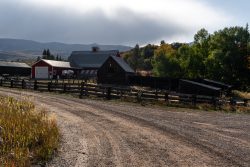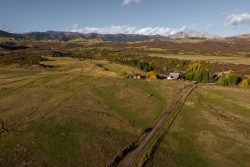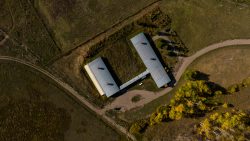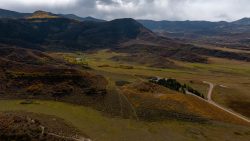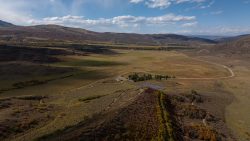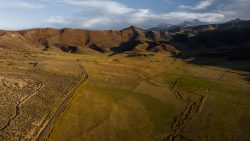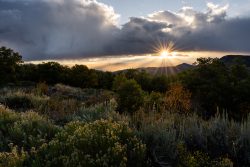Featuring
- 30 minutes from Aspen
- Situated in a private mountain valley in the pristine Capitol Creek Valley
- The largest property of its kind near Aspen
- Three creeks meander through the ranch for over 5 miles
- Irrigated meadows with historic water rights irrigating 1,200 acres
- Features three main characteristics:
- The 2,780 +\- acre main headquarters, including the monastery and retreat center
- The 437 +/- acre West Meadow, an irrigated mesa that adjoins the Headquarters to the west
- The 567 +/- acre McCartney Mesa to the south that towers over the entire property
- Excellent hunting opportunity as the property sits in Colorado Game Management Unit 43
- Small stream fishing on Capitol Creek
- Exquisite and tranquil lands perfect for hiking, horseback riding, snowshoeing, snowmobiling, and more
- Excellent opportunity for conservation
Introduction
Located just outside Aspen, Colorado, the approximately 3,720 +/- total acre St. Benedict’s Monastery represents the largest holding in the immediate Snowmass/Aspen area. The property sits in a picturesque ranching valley surrounded by the lofty peaks of the Elk Mountain Range. Known for its peace and privacy, the Trappist monks have lived and managed this idyllic ranch for over 68 years. Wildlife and cattle have co-existed for years, and the ranch and adjoining protected lands have retained the same natural habitat and rural characteristics today as they did when the monks first arrived.
Lay of the Land
Locale
The ranch is just 30 minutes from Aspen and enjoys extraordinary, unencumbered views of the snow-capped Elk Range from Haystack Mountain to Mt. Sopris. Three main creeks meander through the ranch for over 5 miles, including Capitol Creek, Lime Creek, and Little Elk Creek. The property is accessed by a County Road, which then dead ends at the National Forest boundary. Elevations on the ranch range from 7,400 to 9,300 feet.
The ranch has three main characteristics: the 2,780 +/—acre main Headquarters, including the monastery and retreat center; the 437 +/—acre Spaulding Mesa, an irrigated mesa that adjoins the Headquarters to the west; and the 567 +/—acre McCartney Mesa to the south, which towers over the entire property.
The headquarters sits in its pristine private valley, which is formed by Lime Creek, Little Elk Creek, and Capitol Creek. Small peaks and mesa tops surround it on three sides that rise from the valley floor. It includes hundreds of acres of meadows, pastures, and miles of cottonwood-lined riparian corridors. The monastery and retreat center is situated on the far eastern side of the valley, with views across the grassy acres of cattle and wildlife grazing to the surrounding mountains and mesas towering over the ranch. Brushy slopes ascend from the meadows to mesas and steep forested hillsides.
Spaulding Mesa rises slightly from the Capitol Creek Valley to a lush irrigated mesa. With its elevated nature, the property has unending panoramic views and is part of a mosaic of other irrigated farms that dominate this pastoral valley. Mt. Sopris and the Elk Range dominate the viewshed. Almost the entire mesa is irrigated with some of the best meadows and water rights on the entire ranch. Opportunities for building envelopes to be tucked within treed areas.
McCartney Mesa overlooks the entire valley. Its lofty height provides unobstructed views of the Elk Range, including Haystack, Daly, and Capitol Peak, the largest peak in the Elks. The Gore Range near Vail and the Sawatch Range towards Independence Pass are also visible. The lower reaches of McCartney Mesa, from Little Elk Creek to the mesa, are tree-covered with scenic small glades and irrigated meadows enveloped by aspens.
Improvements
Most of the property was purchased by the La Moy daily, which raised cattle. The monks purchased additional acreage across the road on Spaulding from the Maurin family and more ground from the Gobos and the Gate families.
Charles Hart built the main house near the entrance in 1907 and there is a barn, office, and equipment sheds nearby. The fine detailing of the brick and window trim and the master craftsmanship of the barn structure are noteworthy for their excellence. The monks originally lived in the old schoolhouse (now converted to a house) down Capitol Creek before moving into the Hart house and had to use the upstairs loft of the barn as their numbers grew.
The monks built and designed the main monastery following the design plan of a 12th-century Cistercian Abbey. Cistercian architecture is beautiful because of its unadorned simplicity, spacious design, and inner sense of quiet. The thick walls, arched windows, and peaked cupolas are reminiscent of the ancient religious retreats in France and Italy. The Monastery was expanded in the mid-80s as its ranks increased. The entire wood shake roof (32,000 sq. ft.) was replaced in 2019 with fire-resistant CeDUR shakes.
Groundbreaking for the retreat center began in 1992 and was consecrated in 1995. The renowned Aspen firm of Conger Fuller designed the center and received an excellence award for religious architecture from the American Institute of Architecture. The center uses passive solar design principles, incorporating daylighting throughout, and is constructed primarily of reclaimed timber and local stone. It is the first successful use of constructed wetlands in Pitkin County. The building’s form draws inspiration from vernacular ranch structures, and the meditation hall provides a tranquil setting for spiritual practitioners to experience the Monastery’s pristine setting. They also designed and built several hermitage cabins around the center and on top of McCartney Mesa. There is the “Gobo” cabin along the banks of Capitol Creek, a home converted from an old schoolhouse near Spaulding Mesa, the “outfitter’s cabin” and other barns and hay barns throughout., The Monastery installed a 202-kilowatt solar photovoltaic system that offsets 100 percent of electricity use throughout the ranch.
Location
St. Benedict’s Monastery is situated near the end of Capitol Creek Road in Snowmass, Colorado, along East Sopris Creek in the Capitol Creek area of Old Snowmass. The headquarters of the property sits at about 7,700 ft. just below Haystack Mountain, where hikers and horseback riders embark on trips into the upper Capitol Creek watershed in the Maroon Bells-Snowmass Wilderness Area and White River National Forest. The area is known for its exhilarating Colorado alpine experiences, with iconic destinations such as Capitol Peak (a Fourteener), Snowmass Lake, and Williams Lake (where John Denver wrote “Rocky Mountain High”), each just a beautiful day trip away.
The Aspen/Snowmass resorts, world-class recreational amenities, and the restaurants and shopping of Aspen are all approximately 30 minutes from the property and 20 minutes to the Pitkin County Airport, where flights connect from many major U.S. cities. The quaint town of Basalt is 20 minutes away.
From Aspen: Take Highway 82 west to Snowmass Creek Road, approximately 12+ miles. Turn south onto Snowmass Creek Road and go 1.8 miles, then right onto Capitol Creek Road. Go 3.8 miles and turn left onto Monastery Road.
From Basalt: Take Highway 82 east for 4 miles. Turn south onto Snowmass Creek Road and go 1.8 miles, then right onto Capitol Creek Road. Go 3.8 miles and turn left onto Monastery Road.
History
Trappist monks came to the Roaring Fork Valley in 1956 and established St. Benedict’s Monastery. Construction of the green brick monastery did not begin until 1958 under the supervision of a pioneer in contemplative prayer and the heartbeat of St. Benedict’s, Rev. Thomas Keating. Rev. Thomas Keating started the Snowmass Interreligious Conference in 1984, which brought leaders of different faiths worldwide to St. Benedict’s Monastery, which lasted for over three decades.
The retreat center at St. Benedict’s was not constructed until 1996 and has since been used for Centering Prayer, private group retreats, and public meditative retreats.
The monks underwent a few different operations at the Monastery, including trying a hand at hard candy. In 1967 they built an eggery and started selling their eggs to local restaurants and farmers’ markets in the Aspen Valley. They moved on to cookies and now lease the ranch to a local cattle rancher.
For more information on the history of St. Benedict’s Monastery, check out this link.
Climate
St. Benedict’s Monastery’s elevation ranges from 7,700 to 9,400 feet in elevation so snow levels and temperatures can differ from the base of the headquarters to the mesas.
Ave Winter Low Temp: 9
Ave Summer High Temp: 79
Days of Sunshine: 245
Annual Snowfall: 151 in.
Annual Rainfall: 20 in.
Sporting Features
Overview
St. Benedict’s Monastery offers a sizable private sanctuary for many activities, including fishing, hunting, horseback riding, hiking, snowshoeing, snowmobiling, and cross-country skiing. Coupled with the general area recreation opportunities, including alpine skiing 30 minutes away at Aspen (Ajax), Aspen Highlands, and Snowmass, the property offers an unparalleled home base for any high-mountain outdoor enthusiast.
Hunting
The hunting at St. Benedict’s Monastery is excellent for any hunting enthusiast. The Monastery is located in Colorado Game Management Unit 43, widely regarded as one of the finest trophy mule deer units in the western United States. Because of the size of the ranch (and associated priority), transferable landowner deer tags may be secured yearly. Deer hunting on the ranch itself is fabulous. Still, the tags also enable one to hunt thousands of acres of the neighboring Snowmass/Maroon Bells Wilderness, including three drainages renowned for producing world-class bucks.
The area is also known for producing some great bull elk as well. A 350’’ elk bull was harvested in the adjacent national forest. Black bears, wild turkeys, and mountain lions are also present. Both residents and non-residents may secure most bull elk tags over the counter. As with deer, tag-holders may hunt the ranch and adjacent public lands.
Fishing
Capitol Creek meanders through the ranch for approximately 2.5 miles. It is a fabulous small-stream fishery with both cutthroat and brook trout. Above the ranch, the Capitol Creek Trail follows the creek for miles through the wilderness, providing limitless fishing opportunities. Trophy rainbows and browns can be pursued on the Gold Medal Roaring Fork and Frying Pan Rivers, both of which are minutes away from the ranch.
Recreation
The awe-inspiring Colorado Rockies are your backyard here. The property provides your own personal trailhead, so recreational offerings include all that these mountains are famous for mountain climbing, hiking, high country lake fishing, horseback riding and packing, backcountry and cross-country skiing, fly-fishing, wildlife viewing, and hunting, as well as all that the nearby, famous resorts and towns offer, such as downhill and cross-country skiing, whitewater rafting, and mountain and road biking. Peak-bagging on Capitol Peak, Mt. Sopris, the Maroon Bells, and other high-profile mountains in this valley and adjacent drainages are popular activities for locals and visitors alike.
Ranch Attributes
Ranch Operations
The ranch has historic water rights that irrigate approximately 1,200 acres and produce quality hay. A local rancher leases out the ranch for cattle and hay production. The ranch has an older eggery on the property as the monks produced and sold eggs to the Aspen community.
Water Rights
Most of the water rights owned by St. Benedict’s are used to irrigate the extensive Monastery grounds. The Monastery can irrigate up to 1,500 acres of hay fields, though, in a typical year, they irrigate closer to 1,200 acres. The St. Benedict water rights are typically reliable but depend on snowpack from the surrounding mountains.
Most fields are irrigated by flood irrigation, but St. Benedict’s owns six side-rolled sprinklers that are capable of irrigating about 40 acres each. St. Benedict’s grows hay with this water, producing, on average, about 300 tons per year. For most of its history, the monks cut, baled, and sold the hay. In recent years, St. Benedict’s sold most of its ranching equipment and began leasing its fields to a neighboring ranch, which has continued to irrigate and grow hay on this property.
St. Benedict’s has worked closely with its neighbors to manage water resources in the area. During times of drought, the neighbors collaborate and share available water supplies. More details are available to vetted prospects.
Mineral Rights
Seller will convey any and all mineral rights owned.
Leases
The property is currently leased for hay production, cattle, horseback riding, and hunting.
Taxes
The property is owned by a religious non-profit organization and has tax-exempt status.
Aesthetic Value
It is one of the most scenic valleys in Colorado, let alone Pitkin County.
Conservation Value
The Maroon Bells-Snowmass Wilderness is only a few miles off the property boundary, and the property adjoins protected lands with conservation easements held by the Aspen Valley Land Trust and Pitkin County Open Space. The property is unencumbered by any conservation easements and is located in a high-value area for low-density and exclusive rural development. It is highly valued for its conservation values, scenic vistas, abundant wildlife, important habitat, and rural and agricultural character.
The Monastery is an excellent candidate for conservation given its inherent conservation values, and other than the spiritual buildings, it has not been developed. The ranch is in a high mountain, rural, and agricultural valley with abundant wildlife, scenic mountains, valley views, endless recreational options, and unrivaled privacy.
Investment Value
Impossible to replicate and find such a property.
 Location Map
Location Map  Satellite Map
Satellite Map 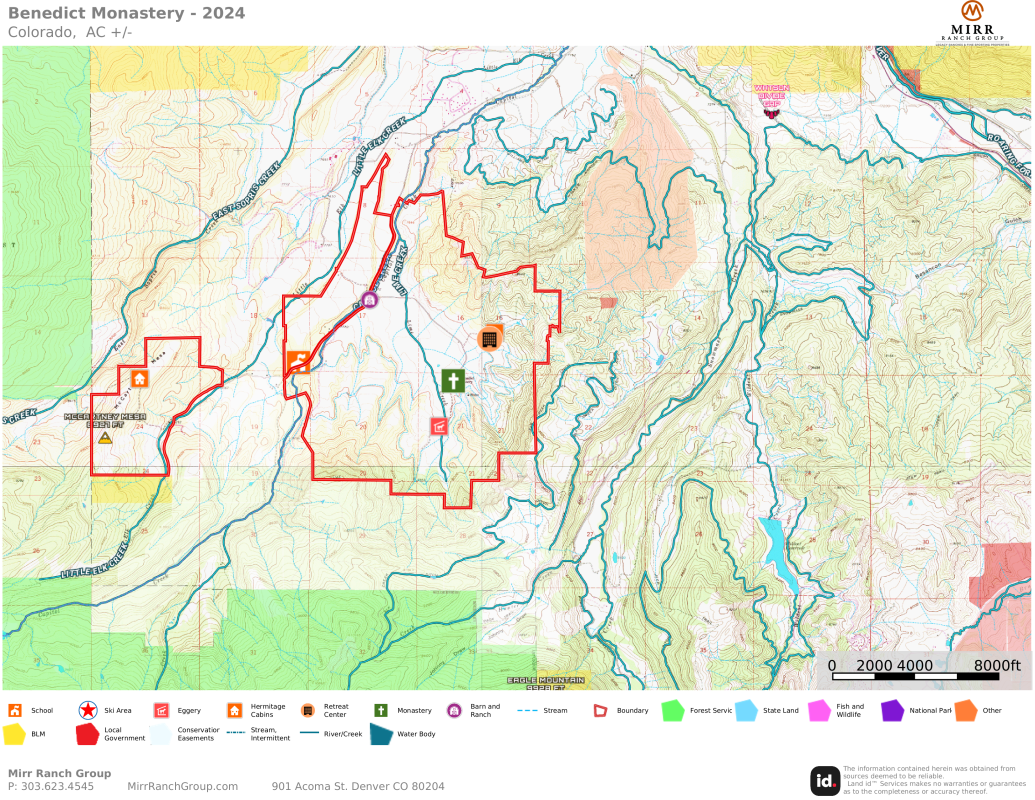 Topo Map
Topo Map 